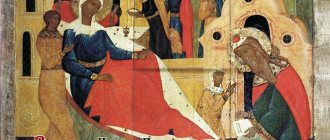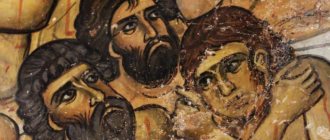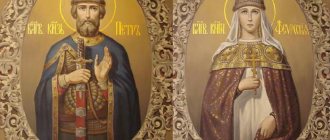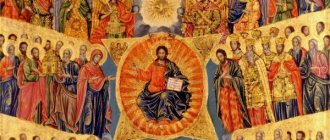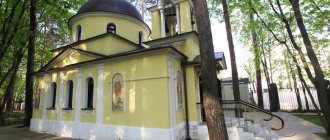This bloody crime cannot be washed away from the conscience of our people. Even after a hundred years, the soul of a Russian person shudders and hurts, remembering these martyrs. God's anointed one, a mother of many children, innocent virgins like buds, a sick, barely alive heir, the crown prince. The lives of these pious people, worthy of imitation and deep respect, were cut short overnight through the fault of their own subjects. How cruelly the people for whom they lived and worked treated them. They had a choice, but they chose Russia. This means death without time...
Who are the Royal Martyrs
Royal Passion-Bearers, Royal Martyrs, Royal Family - this is how, after canonization, the Russian Orthodox Church calls the last Russian Emperor Nicholas II and his family: Empress Alexandra Feodorovna, Tsarevich Alexei, Grand Duchesses Olga, Tatiana, Maria and Anastasia. They were canonized for the feat of martyrdom - on the night of July 16-17, 1918, on the orders of the Bolsheviks, they, along with the court doctor and servants, were shot in Ipatiev’s house in Yekaterinburg.
Children
The first daughter was Olga . She was born in 1895. The girl was smart and well-read. The father doted on his eldest daughter. There were rumors that he wanted to make her heir to the throne.
The second daughter, Tatyana , was born in 1897. She was a beauty with a sophisticated appearance. She also loved to read and embroider.
The third daughter, Maria , was born in 1899. She had a strong physique, excellent health and had enviable physical strength. Her family called her “Mashka” for her simplicity and kindness.
The fourth daughter, Anastasia , was born in 1901. She had a sharp mind and a subtle sense of humor. The girl adored her younger brother. They could often be found playing together.
The heir, Alexey , was born in 1904. His parents were incredibly happy about his appearance. After all, they prayed for his appearance in Diveevo during the glorification of St. Seraphim of Sarov. Then blessed Pashenka predicted the birth of a son to the empress. But soon their joy was darkened when it turned out that the baby had a hereditary disease. Hemophilia (incoagulability of blood) was passed on to Alyosha from Queen Victoria. All male members of the royal family suffered from this disease.
All the children of the royal family were very friendly and loved their parents. They were brought up in the spirit of severity, they were not allowed luxury or bliss. They slept on hard beds and were taught to work from childhood. Therefore, later in exile they easily coped with garden work.
What does the word “passion-bearer” mean?
“Passion-bearer” is one of the ranks of holiness. This is a saint who accepted martyrdom for fulfilling God’s Commandments, and most often at the hands of fellow believers. An important part of the passion-bearer’s feat is that the martyr does not hold a grudge against his tormentors and does not resist.
This is the face of saints who suffered not for their actions or for preaching Christ, but for who they were. The fidelity of the passion-bearers to Christ is expressed in their fidelity to their calling and destiny.
It was in the guise of passion-bearers that Emperor Nicholas II and his family were canonized.
Murder of the Romanov family
The last Russian emperor, Nicholas II Romanov, abdicated the throne on March 2, 1917. After his abdication, he, along with his family, doctor and servants, were placed under house arrest in the palace in Tsarskoye Selo. Then, in the summer of 1917, the Provisional Government sent the prisoners into exile in Tobolsk. And finally, in the spring of 1918, the Bolsheviks exiled them to Yekaterinburg. It was there that on the night of July 16-17, the Royal Family was shot - by order of the executive committee of the Ural Regional Council of Workers', Peasants' and Soldiers' Deputies.
Some historians believe that the order for execution was received directly from Lenin and Sverdlov. The question of whether this is so is controversial; perhaps historical science has yet to find out the truth.
Very little is known about the Ekaterinburg period of exile of the Royal Family. Several entries in the emperor's diary have reached us; There are testimonies from witnesses in the case of the murder of the Royal Family. In the house of engineer Ipatiev, Nicholas II and his family were guarded by 12 soldiers. Essentially, it was a prison. The prisoners slept on the floor; the guards were often cruel to them; prisoners were allowed to walk in the garden only once a day.
The royal passion-bearers courageously accepted their fate. A letter from Princess Olga has reached us, where she writes: “Father asks us to tell all those who remained devoted to him, and those on whom they may have influence, that they do not take revenge for him, since he has forgiven everyone and is praying for everyone, and so that they do not avenge themselves, and so that they remember that the evil that is now in the world will be even stronger, but that it is not evil that will defeat evil, but only love.”
Those arrested were allowed to attend services. Prayer was a great consolation for them. Archpriest John Storozhev performed the last service in the Ipatiev House just a few days before the execution of the Royal Family - July 14, 1918.
On the night of July 16-17, the security officer and leader of the execution, Yakov Yurovsky, woke up the emperor, his wife and children. They were ordered to gather under the pretext that unrest had begun in the city and they urgently needed to move to a safe place. The prisoners were escorted to a semi-basement room with one barred window, where Yurovsky informed the Emperor: “Nikolai Alexandrovich, according to the resolution of the Ural Regional Council, you and your family will be shot.” The security officer shot several times at Nicholas II, and other participants in the execution shot at the rest of the condemned. Those who fell but were still alive were finished off with shots and bayonets. The bodies were taken out into the yard, loaded into a truck and taken to Ganina Yama - an abandoned Isetsky. There they threw it into a mine, then burned it and buried it.
Along with the Royal family, the court doctor Yevgeny Botkin and several servants were shot: the maid Anna Demidova, the cook Ivan Kharitonov and the valet Alexei Trupp
On July 21, 1918, during a service in the Kazan Cathedral in Moscow, Patriarch Tikhon said: “The other day a terrible thing happened: the former Sovereign Nikolai Alexandrovich was shot... We must, obeying the teaching of the word of God, condemn this matter, otherwise the blood of the executed person will fall on us, and not only on those who committed it. We know that he, having abdicated the throne, did so with the good of Russia in mind and out of love for her. After his abdication, he could have found security and a relatively quiet life abroad, but he did not do this, wanting to suffer with Russia. He did nothing to improve his situation and resignedly resigned himself to fate.”
For many decades, no one knew where the executioners buried the bodies of the executed Royal Martyrs. And only in July 1991, the presumed remains of five members of the imperial family and servants were discovered near Yekaterinburg, under the embankment of the Old Koptyakovskaya Road. The Russian Prosecutor General's Office opened a criminal case and during the investigation confirmed that these were indeed prisoners of the Ipatiev House.
After several years of research and public controversy, on July 17, 1998, the martyrs were buried in the Peter and Paul Cathedral in St. Petersburg. And in July 2007, the remains of the son of Tsarevich Alexei and Grand Duchess Maria were found.
Queen Alexandra
Princess Alice of Darmstadt was the granddaughter of Queen Victoria. She was born in 1872 in Darmstadt and baptized in the Lutheran Church. The mother was very pious, she strove to keep God’s commandments, to help people, the sick and the poor, because of which she received a fatal illness. After the death of the mother, the family was left with seven children. Soon his father, Duke Ludwig the Fourth, also died.
The mother instilled in the children faith in Christ , piety and the desire to help people. These qualities can be seen in Alice. At the wedding of her older sister (the future Princess Elizabeth) and Prince Sergei, she met young Nicholas. He admitted later that he fell in love with her at first sight. Princess Elizabeth assisted their correspondence. A few years later, Nikolai proposed to Alice. Their love was like a fairy tale. Their feelings remained fresh, despite a quarter of a century of marriage. Their touching correspondence has survived to this day.
After the discovery of her youngest son's illness, the empress suffered from a serious heart disease. She could hardly walk and had severe shortness of breath. But, despite her serious illness, the empress worked in a hospital during the war, cared for the wounded and helped her sister (Princess Elizabeth) perform difficult operations.
Alexandra Fedorovna had great fortitude. She not only did not despair in difficult times, but also knew how to support her husband. During the difficult time of the abdication of the sovereign, she and her children were seriously ill. But she did not lose heart, comforting her children and husband.
Canonization of the Royal Family
People abroad have been praying for the repose of the Royal Family since the 1920s. In 1981, the Russian Orthodox Church Abroad canonized Nicholas II and his family.
The Russian Orthodox Church canonized the Royal Martyrs almost twenty years later - in 2000: “To glorify the royal family as passion-bearers in the host of new martyrs and confessors of Russia: Emperor Nicholas II, Empress Alexandra, Tsarevich Alexy, Grand Duchesses Olga, Tatiana, Maria and Anastasia.”
How did the 2015–2021 investigation differ from the previous one (1993–2011)?
The difference between the new investigation and the old one is in the scope of the examinations carried out. In particular, the genetic examination conducted by Evgeny Rogaev, unlike the examinations of the 90s, carried out DNA analysis not only on the female, but also on the male line of inheritance (in the 90s, such scientific methods did not yet exist). For comparative DNA analysis, the remains of Nicholas II's father, Emperor Alexander III, were exhumed in St. Petersburg.
In total, more than 70 different expert opinions were received, including from anthropologists, forensic experts, dentists, handwriting experts, soil scientists, and historians. None of the experts involved in the investigation disputed the conclusions of the Investigative Committee.
Why do we honor the Royal Passion-Bearers?
Archpriest Igor FOMIN, rector of the Church of the Holy Blessed Prince Alexander Nevsky at MGIMO:
“We honor the royal family for their devotion to God; for martyrdom; for giving us an example of real leaders of the country who treated it like their own family. After the revolution, Emperor Nicholas II had many opportunities to leave Russia, but he did not take advantage of them. Because he wanted to share the fate with his country, no matter how bitter this fate was.
We see not only the personal feat of the Royal Passion-Bearers, but the feat of all that Rus', which was once called leaving, but which is in fact abiding. As in 1918 in the Ipatiev House, where the martyrs were shot, so here, now. This is a modest, but at the same time majestic Rus', in contact with which you understand what is valuable and what is of secondary importance in your life.
The royal family is not an example of correct political decisions; the Church glorified the Royal Passion-Bearers not for this at all. For us, they are an example of the ruler’s Christian attitude towards the people, the desire to serve them even at the cost of their lives.”
Prayer text
There are several options for prayers in honor of the royal holy martyrs. The main ones are the following:
“Oh, holy seven days, gifts of passion-bearers Nicholas, Alexandro, Alexie, Maria, Olgo, Tatiano and Anastasia!
You are united by the union of the love of Christ, your home, like a small church, is piously located by nature and has been adorned by nature with humility in the midst of earthly grandeur. During the fratricidal war and persecution of atheists in our homeland, placing all hope in God, the image of patience and suffering of the entire land of Russia appeared naturally and, praying for the torturers, slander, connections and exile, bullying, ridicule and slander, murder and physical abuse of courage were natural. For this reason, nature passed from the earthly to the Celestial Kingdom, and the warmth of the intercessors seemed natural to us.
O holy saints of God! Pray to God for us that the church will maintain the same mentality and be more firm in the faith, protect our country with peace and prosperity and save our country from strife and division, wisdom in power, adorn the army with courage, save the people from ruin, strengthen Christian spouses in fidelity and love, children, it will grow in piety and obedience, and all of us together with you will deign to chant the Prestigious and Magnificent Name of the life-giving Trinity of the Universe. Father, and Son, and Holy Spirit now, and always, and forever and ever. Amen".
Icon of the Royal Martyrs
Traditionally, icon painters depict the Royal Passion-Bearers without a doctor and servants, who were shot along with them in Ipatiev’s house in Yekaterinburg. We see on the icon Emperor Nicholas II, Empress Alexandra Feodorovna and their five children - princesses Olga, Tatiana, Maria, Anastasia and the heir Alexei Nikolaevich.
In the icon, the Royal Passion-Bearers hold crosses in their hands. This is a symbol of martyrdom, known from the first centuries of Christianity, when followers of Christ were crucified on crosses, just like their Teacher. At the top of the icon two angels are depicted; they carry the image of the “Sovereign” icon of the Mother of God.


